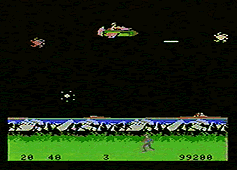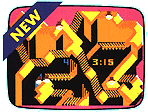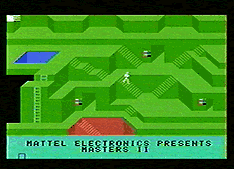

Having already established the M Network line to release videogames for the Atari 2600, it was natural that Mattel would extend the line to include Colecovision after that system was introduced with great success.
Developing Colecovision games, however, was trickier. Figuring out how to program an Atari 2600 comes from examining the hardware; a Colecovision, however, like an Intellivision, contains an operating system in ROM.
At Mattel, programmer David Akers (Star Strike for the Atari 2600) did, on his own and on his own time, figure out how much of the Colecovision operating system worked. One day he just sort of said, "Look what I did," and demonstrated a simple Colecovision program. Everyone was impressed, except for the legal department; they were apoplectic.
The operating system ROM was considered by Coleco to be proprietary and top secret. When releasing a game for Colecovision (or Intellivision for that matter), you had to be able to prove you figured out what is in that ROM by yourself (a procedure known as reverse-engineering), or be open to charges of industrial espionage (as when Mattel sued Atari for $40 million for hiring away several Intellivision programmers).
The burden of proof is on the company doing the reverse-engineering, so the work has to be done under intensely controlled and documented circumstances. The lawyers were afraid that if word of Dave's experimentation got out, Mattel could be sued by Coleco. Dave was told to stop and the people who knew about his work were told to keep it secret.
But Mattel Electronics Marketing soon asked for Colecovision games. Despite the work Dave had already done, Mattel bought a how-to manual on Colecovision programming from Sound Software of Olympia, Washington. They had reverse-engineered the Colecovision themselves and were selling the information (for $50,000 we were told) to companies who didn't want to go through all the trouble of (a) deciphering the code and (b) documenting that it had been done legitimately and legally.
Armed with this squeky-clean documentation, development of Colecovision games began in July 1983 in Mattel's Hawthorne, California and in its Nice, France offices. Only one of the Hawthorne games, Masters of the Universe: The Power of He-Man, neared completion before the division was closed, and Mattel never released a Colecovision title.
At the French office, however, which continued to work after the rest of Electronics had been shut down, three Colecovision games were completed: BurgerTime, Bump 'N' Jump and Illusions. Under their agreement with Mattel, the French office (newly named Nice Ideas) was free to shop the games to other publishers. Coleco finally released them.
![]() FUN FACT: Manager Keith Robinson was put in charge of Colecovision development in Hawthorne. One idea he and programmer Tom Priestley had was to convert the Intellivoice games for Colecovision. Although the voice lab had been shut down, speech had already been synthesized for nine Intellivision games, released and unreleased, plus foreign versions of several of those titles.
FUN FACT: Manager Keith Robinson was put in charge of Colecovision development in Hawthorne. One idea he and programmer Tom Priestley had was to convert the Intellivoice games for Colecovision. Although the voice lab had been shut down, speech had already been synthesized for nine Intellivision games, released and unreleased, plus foreign versions of several of those titles.
After the commercial failure of Intellivoice, Mattel obviously wasn't going to create a voice module for Colecovision. The key to their idea was that the cost of the General Instuments speech synthesis chip had dropped to the point where it would be practical to put a synthesis chip into every cartridge. (This idea came from the M Network Atari 2600 cartridges. Mattel had originally planned on releasing an Atari expansion module with extra RAM for "big games," but the Intellivoice flop made them decide to simply add RAM chips to the big game cartridges.)
To demonstrate their idea, Keith and Tom bought a talking clock chip kit at Radio Shack. Tom cobbled together a cartridge from the parts and Keith slapped together a Colecovision program to trigger it. It worked perfectly. (The only problem with the cartridge was that a Colecovision doesn't have an audio-input pin on its cartridge port - the voice cartridge had to be plugged into the Colecovision's expansion port.)
Keith and Tom demonstrated the talking Colecovision to Vice President Gabriel Baum, who excitedly took it to Marketing. Unknown to Keith or Tom, Gabriel had just been forced to put together a list of programmers and artists to be laid off in November. Armed with the "Colecovoice" idea, Gabriel was able to convince upper management to save about six programmers to develop the idea.
The lay-off came and the programmers were saved, but no further work was done on "Colecovoice."
 CATALOG DESCRIPTION
CATALOG DESCRIPTION
As chef PETER PEPPER, you are trying to build terrific hamburgers while
menacing hot dogs, pickles and eggs are out to ruin your meal! Based on
the arcade game.
DEVELOPMENT HISTORY
The success of Intellivision BurgerTime caused Marketing to ask for the game on every platform possible. This Colecovision version was done at the Mattel office in France. The game was announced at the January, 1984 Consumer Electronics Show in Las Vegas.
Although Mattel Electronics was closed a few weeks later, the French office stayed in business under the name Nice Ideas. They completed BurgerTime, which was distributed by Coleco.
 CATALOG DESCRIPTION
CATALOG DESCRIPTION
If you can't bump 'em, you've got to jump 'em! It's the wackiest thing
to happen to driving since the rush hour. Based on the arcade game.
DEVELOPMENT HISTORY
Like Colecovision BurgerTime, the
Colecovision version of Intellivision Bump 'N' Jump was programmed at the Mattel Electronics offices in France. And also like BurgerTime, since Mattel got out of the videogame business prior to the game's completion, it was
released by Coleco.

 CATALOG DESCRIPTION
CATALOG DESCRIPTION
In this game based on the 1982 "Toy of the Year" male action series,
you are He-Man and must make it the CASTLE GRAYSKULL to defeat
SKELETOR.
DEVELOPMENT HISTORY
The success of Masters of the Universe: The Power of
He-Man on the Intellivision caused
Marketing to order the game for every platform possible ("all
flavors"). Despite being assigned a production number higher than
BurgerTime and Bump 'N' Jump, this was to be the first Colecovision game produced at Mattel, so the job went to Stephen Roney.
Steve was one of the most senior programmers then on staff, with experience on "first time" projects. He was programmer on the first Intellivoice game (Space Spartans) and on the first (and only) game at Mattel programmed in C (Utopia for Aquarius).
Steve put together the program, which was announced and shown at the the January, 1984 Consumer Electronics Show in Las Vegas. The game was essentially finished, needing just a little fine tuning.
But Mattel Electronics closed down just a few weeks later, and Masters of the Universe: The Power of He-Man for Colecovision was never released. The game was not exhibited again until a party held by the Blue Sky Rangers at the 1999 Game Developers' Conference.
The screen shots shown here are the first actual screen
captures from the game ever released.
 CATALOG DESCRIPTION
CATALOG DESCRIPTION
The enchanted mirror splits you into multiple images. You must become
whole before time runs out. Changing stairways and folding cubes try to
keep you from safety.
DEVELOPMENT HISTORY
Illusions was an original game created at the French
office. A Colecovision and an
Intellivision version
were developed
simultaneously. Both versions were announced and shown at the January, 1984
Consumer Electronics Show in Las Vegas.
After Mattel Electronics closed down, the rights to the game went to the newly independent French office (Nice Ideas). They were able to get Coleco to distribute the Colecovision version, but the Intellivision version was never released.
DEVELOPMENT HISTORY
With Dungeons & Dragons proving to be the strongest license Mattel had obtained, it was natural that a D&D game would be high on the list to do for Colecovision. Making it on the list, however, is as far as this title got. No planning of what the game would be or look like was begun before Mattel Electronics closed.
It doesn't appear that any public announcement of this game was ever made.
 DEVELOPMENT HISTORY
DEVELOPMENT HISTORY
The success of Masters of the Universe: The Power of He-Man on the Intellivision was big enough that a sequel was started almost as soon as the game was shipped to stores. And for the sequel, it was decided that Intellivision and Colecovision versions would be developed simultaneously.
As Ray Kaestner defined the 3-D scrolling world of Masters II on Intellivision, Eric Del Sesto translated it for Colecovision. Unfortunately, while Ray ultimately was able to finish his version as Diner for INTV Corporation, Eric's version went unfinished.
It doesn't appear that any public announcement of this game was ever
made. The screen shot shown here is the first actual screen
capture from the game ever released.
DEVELOPMENT HISTORY
Marketing so liked an Intellivision special effect developed by Stephen Roney, they ordered games based on it for "all flavors," including Colecovision. Despite being assigned a production number, no one ever worked on the project.
It doesn't appear that any public announcement of this game was ever made.
DEVELOPMENT HISTORY
With the success of BurgerTime, marketing ordered up a sequel - PizzaTime. The programming was scheduled to begin in France in January 1984, but Mattel Electronics closed the same month. (An Intellivision version was also ordered but never started.)
It doesn't appear that any public announcement of this game was ever made.
DEVELOPMENT HISTORY
Marketing gave the green light to this flying carpet game that originated in the French office. The programming was scheduled to begin in France in February 1984, but Mattel Electronics was closed by then. (An Intellivision version was also ordered but never started.)
It doesn't appear that any public announcement of this game was ever made.
DEVELOPMENT HISTORY
Marketing was impressed enough with the early screens of Josh Jeffe's Intellivision Hydroplane to schedule it for Colecovision. No one was ever actually assigned to the project.
It doesn't appear that any public announcement of this game was ever made.
![]() FUN FACT: The production number for this game - 7866 - was the highest (and last) ever assigned to a Mattel Electronics project.
FUN FACT: The production number for this game - 7866 - was the highest (and last) ever assigned to a Mattel Electronics project.
 Return to Blue
Sky Rangers home page
Return to Blue
Sky Rangers home page
